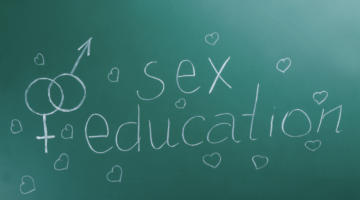3 Theories Behind Why We Kiss
September 4, 2020 by Justin Lehmiller
Kissing is one of the most common sexual and romantic behaviors in many cultures around the world; however, kissing is far from a universal activity. In fact, researchers haven’t found evidence of kissing in a surprisingly large number of cultures around the world.
But in those cultures where kissing does occur, why is that? I mean, how did locking lips, touching tongues, and swapping saliva ever become a thing in the first place? Here’s a look at some of the main theories behind the popularity of kissing:
Kissing is pleasurable
First, the lips are an erogenous zone—an area of heightened sensitivity due to a high concentration of nerve endings. As a result, oral touch and stimulation has the potential to be a highly pleasurable activity. And when we engage in behaviors that feel good, we tend to repeat them. So the fact that kissing can be very pleasurable is a big part of the reason so many of us do it. At the same time, however, kissing is also an activity that many of us have learned as a way to express affection and to develop intimacy. So it’s not just about pleasure—it’s a learned behavior that many of us have come to see as promoting closeness.
We may kiss for reasons that go well beyond this, though. In fact, some research suggests that kissing could potentially be an evolved behavior that helps us to identify good mates. It might also very well benefit our health—and the health of our offspring.
Kissing can help us to “size-up” a partner
Some scientists believe that kissing can potentially help us to evaluate the quality of a potential partner. Getting up close and personal—and literally smelling and tasting our partners—might be a way that we evolved to pick up on chemical signals that help us to identify higher quality mates. Consistent with this idea, some research has found that when women are at the most fertile phase of the menstrual cycle, they rate kissing as more important compared to other times of the month [1]. This supports the idea that kissing could potentially be an evolved mate selection tool.
Kissing might be good for our health
At the same time, another theory is that we evolved to kiss in order to maintain good health through the exchange of bacteria. One study found that a single deep kiss promotes the exchange of as many as 80 million bacteria [2]! The more that a couple kisses, the more similar the bacterial composition of their mouthes become.
How might this benefit our health? One theory is that if kissing a partner occurs before pregnancy, it increases the chances of certain infections—such as human cytomegalovirus or HCMV—taking place at a time when they’re unlikely to cause problems. When HCMV is contracted during pregnancy, it can be detrimental to the health of the fetus. So perhaps kissing is a way to controlling exposure to infections that could negatively impact reproductive success.
No single theory is definitive, and it’s certainly possible that there is some truth to more than one of these theories. However, what the research suggests is that kissing might have a much deeper meaning than any of us ever realized.
Want to learn more about Sex and Psychology ? Click here for previous articles or follow the blog on Facebook (facebook.com/psychologyofsex), Twitter (@JustinLehmiller), or Reddit (reddit.com/r/psychologyofsex) to receive updates. You can also follow Dr. Lehmiller on YouTube and Instagram.
[1] Wlodarski, R., & Dunbar, R. I. (2013). Menstrual cycle effects on attitudes toward romantic kissing. Human Nature, 24(4), 402-413.
[2] Kort, R. et al. (2014). Shaping the oral microbiota through intimate kissing. Microbiome.
Image Source: 123RF/Olena Yakobchuk
You Might Also Like:

Dr. Justin Lehmiller
Founder & Owner of Sex and PsychologyDr. Justin Lehmiller is a social psychologist and Research Fellow at The Kinsey Institute. He runs the Sex and Psychology blog and podcast and is author of the popular book Tell Me What You Want. Dr. Lehmiller is an award-winning educator, and a prolific researcher who has published more than 50 academic works.
Read full bio >


